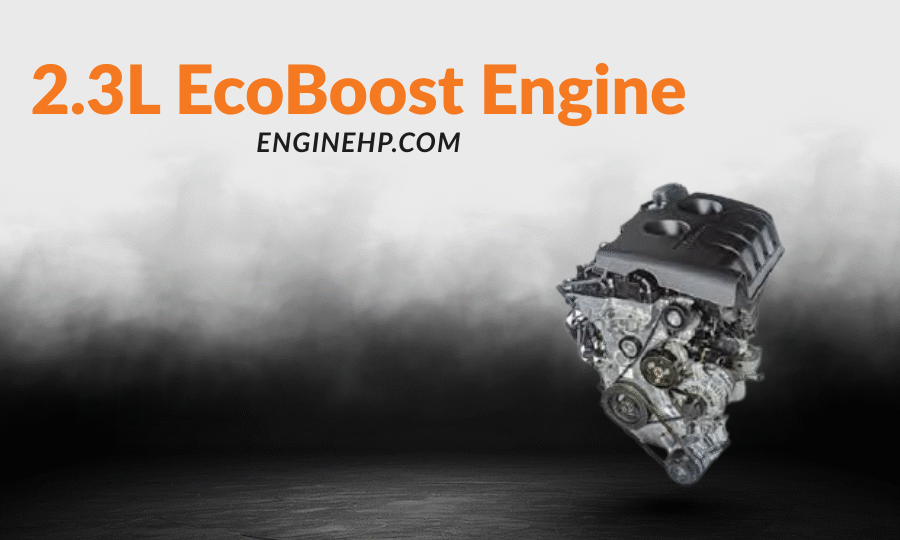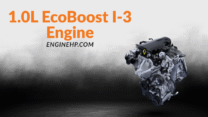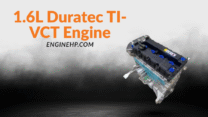
Ford Engines: 2.3L EcoBoost Engine Hp, Reliability, and Performance
The 2.3L EcoBoost engine gives Ford the edge of power and economy in one package. This turbocharged engine is the best of both worlds whether in a sports car, a family SUV or a commercial vehicle. What is really special about the 2.3L EcoBoost? This article will discuss its capabilities, its performance and the reasons as to why it has become such a sought after purchase by both buyers and businesses.
What is the 2.3L EcoBoost Engine?
The 2.3L EcoBoost is a four-cylinder, turbocharged item that is designed by Ford in its EcoBoost series of power plants. It adopts up to date technology such as turbocharging and direct fuel injection (GTDI) to give an output that is similar to bigger engines but yet it has a higher fuel economy. The term EcoBoost is used to stress the idea of environmentally friendly and performance oriented engines offered by Ford.
The 2.3L EcoBoost made its debut in 2009 and has since become a favorite in several of Ford models, such as the Ford Mustang, Ford RS, and Ford Ranger, because of its combination of power and efficiency. The 2.3 L has been created to satisfy auto owners that not only desire high performance but also want to retain fuel economy and low emissions.
Key Features of the 2.3L EcoBoost Engine
- Turbocharging for Enhanced Power
The 2.3L EcoBoost engine that it is associated with has two features: a turbocharger that is used so that more air is forced into the cylinders of the engine. This allows the engine to consume more fuel and produce more energy without enlarging the size of that engine. This ensures that you obtain the power of a bigger engine but in a smaller, compact form the small engine.
- Direct Fuel Injection (DFI) Technology
DFI is very important in enhancing fuel economy. By injecting the fuel directly into the combustion chamber, this provides a more accurate air-fuel ratio, therefore, a superior combustion. This not only gives it more power, better fuel economy and produces lower emissions and makes the 2.3L EcoBoost an environmentally conscious choice that does not sacrifice any performance components.
- Intercooling for Optimal Performance
The turbocharger contains air that leads to heat due to the compression of air. To make sure that such a heat is not able to impact on engine performance, 2.3L EcoBoost is designed with an intercooler that cools the intake air down before it can enter the combustion chamber. This makes the engine run at optimal efficiency, even when under excessive acceleration, or heated conditions.
- Variable Valve Timing (VVT)
Variable valve timing is a modification in the timing of the intake and exhaust valves that vary not only with engine speed but with engine load. This enables the engine to work better fuel economy and responsiveness. VVT plays a major role in how the 2.3L EcoBoost shifts gears to provide an experience of a smooth and responsive drive.
- Lightweight, Compact Design
The positives of the 2.3L EcoBoost are that it is made small and lightweight. The decreased size of the engine enables the vehicle to have fewer weight, therefore enhancing handling, acceleration, and fuel consumption. This is why it would be a perfect choice on sporty cars, cross-overs, and even trucks which have to have a combination of power and fuel economy.
Performance: How the 2.3L EcoBoost Stands Out
Performance wise, one can never complain about 2.3L EcoBoost. The engine reaches between 270 and 350 horsepower and 300 to 370 lb-ft of torque depending on the vehicle it is powering. This qualifies it to perform ideally in high-performance models such as the Ford Mustang EcoBoost, as it is more than powerful enough to facilitate vigorous driving.
Torque-wise, the 2.3L EcoBoost delivers with a wide powerband that delivers best-in-class low-end torque. This guarantees a free acceleration and impressive power, even when the engine is not running so fast. Eng Serge Turbo charger ensures a very responsive engine, giving you impressive acceleration when you need to get the most out of the car.
On fuel economy front, the 2.3L EcoBoost is a balanced blend of power and fuel efficiency. The vehicle has an average of 2024 MPG in the city and 2832 MPG on a highway, which makes it ideal when a consumer wants a high-performance yet does not want to go to the gas station constantly.
2.0L EcoBoost GTDI Engine Specifications
| Specification | Details |
| Manufacturer | Valencia Engine Plant, Valencia, Spain; Cleveland Engine Plant, Ohio, USA |
| Production Years | 2015–present |
| Cylinder Block Material | Aluminum |
| Cylinder Head Material | Aluminum |
| Fuel Type | Gasoline |
| Fuel System | Direct fuel injection |
| Configuration | Inline |
| Number of Cylinders | 4 |
| Valves per Cylinder | 4 |
| Valvetrain Layout | DOHC |
| Bore (mm) | 87.5 mm (3.43 in) |
| Stroke (mm) | 94.0 mm (3.70 in) |
| Displacement (cc) | 2,264 cc (138.2 cu in) |
| Type of Internal Combustion Engine | Four-stroke, turbocharged |
| Compression Ratio | 9.5:1 |
| Power (hp) | 280–350 hp (209–261 kW) @ 5,500–5,600 rpm |
| Torque (lb-ft) | 305–350 lb-ft (414–475 Nm) @ 2,750–3,200 rpm |
| Engine Weight | – |
| Firing Order | 1-3-4-2 |
| Engine Oil Capacity (liter) | 5.4 l (5.7 qt) |
| Engine Oil Weight | SAE 5W-30 (Oil recommendations and capacity may vary depending on the car model, year, and market. Please check the service manual specific to your vehicle!) |
| Oil Change Interval (mile) | 9,000 miles (15,000 km) or 12 months |
| Cars with This Engine | Ford Explorer, Ford Ranger, Ford Mustang EcoBoost, Ford Focus RS, Lincoln MKC, Zenos E10 R, VUHL 05 RR |
Why Should Buyers Consider the 2.3L EcoBoost Engine?
- Performance with Efficiency
If you have a soft spot in your heart for the idea of driving a car, but you do not want to endure the miserability of having to fill your car with gasoline, the 2.3L EcoBoost is a great alternative. This engine can be found in a sports car, a pickup truck, or an SUV, and in all of them it delivers a dynamic drive but at the same time, it keeps fuel consumption at level. It is a perfect fit to those interested in performance that wish to have both and take it as well.
- Eco-Friendly Power
The 2.3L EcoBoost engine has a turbocharged construction as well as direct fuel injection, which makes it have a degree of operating economy as small engines. It is an ideal alternative to competitive products and still offer the purchase of buyers who are environmentally conscious and interested in having a high-performance car. The low emissions of the engine make it greener alternative to the traditional gasoline engines at no loss of power.
- Versatility Across Multiple Vehicle Types
The 2.3L EcoBoost can be found in more than sports cars. It can also be integrated into diverse kinds of vehicles, such as the small and manoeuvrable Ford Focus RS and the sturdy Ford Ranger. Depending on what you need in a car, whether exciting acceleration and power or something that can take the rigours of everyday life, 2.3L EcoBoost will provide a balanced and capable choice.
- Affordability and Maintenance
The 2.3L EcoBoost engine is accessible both in-terms of initial price and long-term care. Due to the variety of Ford models where the engine is applied, the availability of the parts is gratifying and quite affordable. It offers better fuel efficiency, powerful, turbocharged engine, and at the same time is able to maintain low maintenance costs as compared to when one uses larger turbocharged engines.
- Impressive Towing Capacity
Although it is a four-cylinder unit, 2.3L EcoBoost has an impressive towing capability. In vehicles such as the Ford Ranger it allows the vehicle to tow up to 7,500 pounds when equipped properly and as such provides a vehicle with a great level of towing capabilities without the need to move up to larger engines.
The 2.3L EcoBoost Engine in the Automotive Industry
The 2.3L EcoBoost engine has been able to change the perception of drivers in regards to what they expect of their cars. It is a bright spot that has emerged to show how new turbocharged engines are capable of high performance without compromising fuel consumption, nor the emissions. To car manufacturers, the 2.3L EcoBoost engine can be used to get powerful vehicles that appeal to the needs of many customers, including those who thrive on a powerful vehicle, and those that believe in saving the environment.
As Ford keeps innovating, 2.3L EcoBoost engine stays part of the equation meant to provide customers with power, economy, and environmentally-friendly cars. This engine is a win situation to business owners in the automotive industry because it enables them to achieve the required fuel economy and emissions as required by the authorities and consumers.
Where Can You Find the 2.3L EcoBoost Engine?
Most of the vehicles in which the 2.3L EcoBoost engine has been installed include the following high-performance and utility vehicles:
- Ford Mustang EcoBoost: The sports car has a 2.3L EcoBoost that gives balance between speed, power, and fuel consumption.
- Ford Ranger: The midsize pickup truck features good towing and cargo carrying capabilities coupled with resourcefulness that the 2.3L EcoBoost brings to it.
- Focus RS: The hot hatch powered by 2.3L EcoBoost engine to provide an incredible performance and handling.
- Ford Edge: This is a medium sized sport utility vehicle that blends both performance and functionality into a fuel economy friendly 2.3L EcoBoost engine.
The engine is also extended among other vehicles manufactured by different manufacturers that have entered into partnership with Ford.
Challenges and Considerations When Buying a 2.3L EcoBoost Vehicle
Although 2.3L EcoBoost engine has numerous advantages, there are some factors that buyers need to consider:
- Turbo Lag:
Although turbo lag is minimized with the modern engines, there is likely to be a little delay in delivering power. This is not a killer, but those interested in performance driving ought to take note of this, especially when accelerating hard.
- Premium Fuel:
Depending on the model, the 2.3L EcoBoost engine can necessitate premium fuel to get its peak performance. Although regular fuel may run, high-quality fuel can make the engine perform to the best of its abilities.
- Initial Cost:
Only slightly more expensive initial cost than similar vehicles with naturally aspirated engines may cause vehicles equipped with 2.3L EcoBoost to be equipped with a slightly higher engine. Nevertheless, these systems are usually superior in the long-term economy of fuel and power output, although they have higher initial cost.
Conclusion: Is the 2.3L EcoBoost Engine Right for You?
In summary, the 2.3L EcoBoost is a stunning engine to any consumer who needs to balance between power, fuel efficiency, and good reliability. It doesn’t matter whether you are looking to buy a sports car, a pickup truck, or an SUV, the 2.3L EcoBoost will meet your demands by providing the speed of a larger engine and the economy of a smaller one. The 2.3L EcoBoost is an engine that will not disappoint individuals who are eager to have powerful, efficient, and versatile engine selection.










Leave a Reply